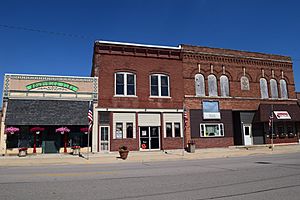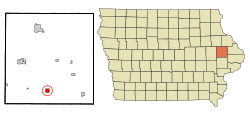Olin, Iowa facts for kids
Quick facts for kids
Olin, Iowa
|
|
|---|---|

Downtown Olin
|
|

Location of Olin, Iowa
|
|
| Country | |
| State | |
| County | Jones |
| Incorporated | November 14, 1879 |
| Area | |
| • Total | 1.03 sq mi (2.67 km2) |
| • Land | 1.02 sq mi (2.65 km2) |
| • Water | 0.01 sq mi (0.02 km2) |
| Elevation | 761 ft (232 m) |
| Population
(2020)
|
|
| • Total | 651 |
| • Density | 636.99/sq mi (245.96/km2) |
| Time zone | UTC-6 (Central (CST)) |
| • Summer (DST) | UTC-5 (CDT) |
| ZIP code |
52320
|
| Area code(s) | 319 |
| FIPS code | 19-58980 |
| GNIS feature ID | 0459851 |
Olin is a small city located in Jones County, Iowa, in the United States. In 2020, about 651 people lived there. Olin is part of the larger Cedar Rapids area.
Contents
History of Olin
Olin was named after D. A. Olin. He was an important person who managed the Chicago, Milwaukee, St. Paul and Pacific Railroad. The city was officially started on November 14, 1879.
Geography and Location
Olin is found at a specific spot on the map: 41.997599 degrees North and -91.139924 degrees West. This means it's in the northern and western parts of the world.
Area of the City
The city covers a total area of about 1.04 square miles (2.67 square kilometers). Most of this area is land, about 1.03 square miles (2.65 square kilometers). A very small part, about 0.01 square miles (0.02 square kilometers), is water.
Population and People
Olin has seen its population change over the years. Here's a look at how many people have lived there:
| Historical populations | ||
|---|---|---|
| Year | Pop. | ±% |
| 1880 | 362 | — |
| 1890 | 519 | +43.4% |
| 1900 | 692 | +33.3% |
| 1910 | 659 | −4.8% |
| 1920 | 718 | +9.0% |
| 1930 | 632 | −12.0% |
| 1940 | 707 | +11.9% |
| 1950 | 626 | −11.5% |
| 1960 | 703 | +12.3% |
| 1970 | 710 | +1.0% |
| 1980 | 735 | +3.5% |
| 1990 | 663 | −9.8% |
| 2000 | 716 | +8.0% |
| 2010 | 698 | −2.5% |
| 2020 | 651 | −6.7% |
| Source: and Iowa Data Center Source: |
||
What the 2020 Census Shows
In 2020, there were 651 people living in Olin. There were 262 households, which are groups of people living together. The city had about 637 people per square mile.
Most of the people in Olin were White (95.7%). A smaller number were Black or African American (1.7%). About 2.6% of the population identified with two or more races. Less than 1% of the people were Hispanic or Latino.
- About 27% of households had children under 18.
- Many households (44.7%) were married couples.
- The average age in Olin was about 37 years old.
- About 26.6% of residents were under 20 years old.
- About 17.5% of residents were 65 years or older.
- The population was almost evenly split between males (51.2%) and females (48.8%).
What the 2010 Census Showed
In 2010, Olin had 698 people. There were 295 households. The population density was about 678 people per square mile.
- Most residents (97.3%) were White.
- About 1.6% of the population was Hispanic or Latino.
- About 29.8% of households had children under 18.
- The average age was 40.8 years.
- About 23.4% of residents were under 18.
- About 17.2% were 65 years or older.
- The gender split was very close: 50.3% male and 49.7% female.
Education in Olin
Olin has its own school district, called the Olin Consolidated Community School District. This district serves Olin and the areas around it.
In 2012, the school board made a big decision. They voted to close the junior and senior high school in Olin. Students from these grades now go to the Anamosa School District. This was part of an agreement to share grades between the two districts for three years.
The sports teams at Olin were known as the Lions. They used to be part of different sports groups, with the last one being the Big East. In 2011, the school stopped its own sports programs. Instead, Olin students now join Anamosa's sports teams.
See also
 In Spanish: Olin (Iowa) para niños
In Spanish: Olin (Iowa) para niños

